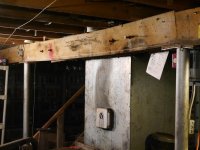2manyrocks
Super Member
- Joined
- Jul 28, 2007
- Messages
- 7,321
Well, the termites have eaten up the center beam of my parent's house. They used rough saw oak lumber because that was the only lumber they could find after WWII. It's a single story house. The beam consists of 3 oak boards nailed together. Each is 1.5"x9.25." The floor joists run past one side of the center beam far enough that my current plan is to build a 2x4 wall 16" OC under them. The wall will rest on a pressure treated 2x4 plate on the concrete floor with a doubled top plate.
Since the walls are plastered, I need to minimize the amount of lift used to get the weight off the existing center beam. One problem is that the beam has already sagged over an inch in the very center of the house.
In cutting the studs for the temporary support wall, how much longer should I cut them to get the weight off the existing center beam? I figure the weight of the building will compress the wood in the top plate and the plate resting on the floor, too. I'm not sure whether to cut the studs say an extra 1/4" too long to start with or whether that is going too far.
I'd like to correct the 1" sag in the center while I'm at this, but am having a little bit of apprehension about fixing a bunch of broken wall plaster later if I go too far.
Since the walls are plastered, I need to minimize the amount of lift used to get the weight off the existing center beam. One problem is that the beam has already sagged over an inch in the very center of the house.
In cutting the studs for the temporary support wall, how much longer should I cut them to get the weight off the existing center beam? I figure the weight of the building will compress the wood in the top plate and the plate resting on the floor, too. I'm not sure whether to cut the studs say an extra 1/4" too long to start with or whether that is going too far.
I'd like to correct the 1" sag in the center while I'm at this, but am having a little bit of apprehension about fixing a bunch of broken wall plaster later if I go too far.
